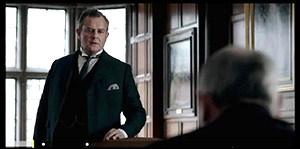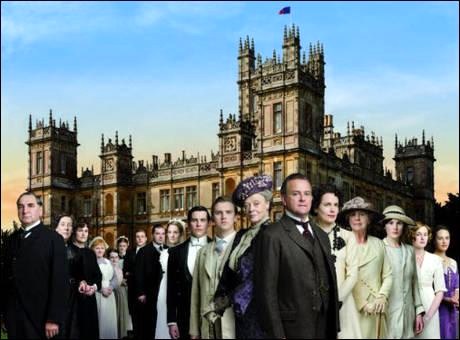By Pam Martens: January 11, 2013

Downton Abbey's Earl of Grantham Getting the News That He Has Lost the Bulk of His Wife's Inheritance On a Railway Stock
If you were among the breathless throng of PBS viewers awaiting the first episode of the third season of Downton Abbey last Sunday evening, and you are a cautious investor, you were no doubt horrified at how the Earl of Grantham had tossed his wife’s fortune and the financial security of his family into a solitary stock now set to file bankruptcy.
Downton Abbey is the British television series written by Julian Fellowes that has become an international sensation. The first season began in the years leading up to World War I. We have now moved along to 1920 in the fictional country estate, Downton Abbey, of the Crawley family, headed by the Earl and Countess of Grantham.
This should be the most joyful time in the Earl of Grantham’s life. His palatial home, which had been turned into a military hospital during the war has now been restored to normalcy and a beautiful wedding is about to take place for his beloved daughter, Mary.
But then the message comes for the Earl to travel to London to receive grave news from his financial advisor. The Earl has put the bulk of his American wife’s fortune, left to her by her father, in the Canadian Grand Trunk Line – a railway stock.
As the Earl learns “almost all” the money has been lost, he asks his advisor why so much money was invested. His advisor reminds him that it was the Earl himself who insisted. The Earl retorts: “It wasn’t just me, everyone said we couldn’t lose.”
The despondent Earl travels home and delivers the news to his wife, who is unrealistically subdued given the fact that it has been her wealth that is supporting Downton Abbey, their daughters, their servants, and their affluent lifestyle. Countess Grantham says simply: “Investing in one enterprise, wasn’t that foolish?”
The Earl made not one, but five critical investment mistakes which have been regularly repeated since time immemorial. The gravest mistake was to invest in a concentrated position – one company, one industry (and a cyclical one no less). Next, he was swayed by the preposterous assurances of acquaintances that he couldn’t lose. (If it is of this world, you can lose it.) Then, it appears, the Earl and his financial advisor failed to properly monitor the stock. Companies with visible hard assets like railroad lines (as opposed to companies like Madoff with imaginary paper assets) rarely go from thriving to bankruptcy overnight. There would typically have been warning signs and intermediate price declines when the position should have been scaled back.
The Earl also did not follow what is known as the Prudent Man Rule. The Earl was effectively acting as a fiduciary of his wife’s large fortune. A prudent man would have diversified her holdings, put some of the money in laddered maturities of government notes and bonds, created trusts for each of their three daughters with the money placed out of harm’s way, and had a liquid rainy day fund to sustain the family.
The Earl then ignored the advice of his financial advisor not to invest so heavily in one railroad stock – apparently relying on his own gut instincts, poorly honed over a protected, pampered life at Downton Abbey. (There are numerous scenes in the series of the Earl, a healthy, fit, middle aged man, being dressed for dinner by a servant. If one can’t rely on their own instincts to dress themselves, it would be a good rule of thumb not to rely on those instincts to invest in stocks.)
As I watched this segment, I thought of the modern day investors who were lulled into complacency in Enron, WorldCom, AIG, Fannie Mae, Freddie Mac, Bear Stearns, Lehman Brothers, Merrill Lynch, Citigroup and dot com companies too numerous to name in the prior era of reckless investing. Unlike the Earl, they had every electronic gadget imaginable to monitor their stock prices. But so many people rode these stocks right into the ditch. Like the Earl, they believed they just couldn’t lose.


